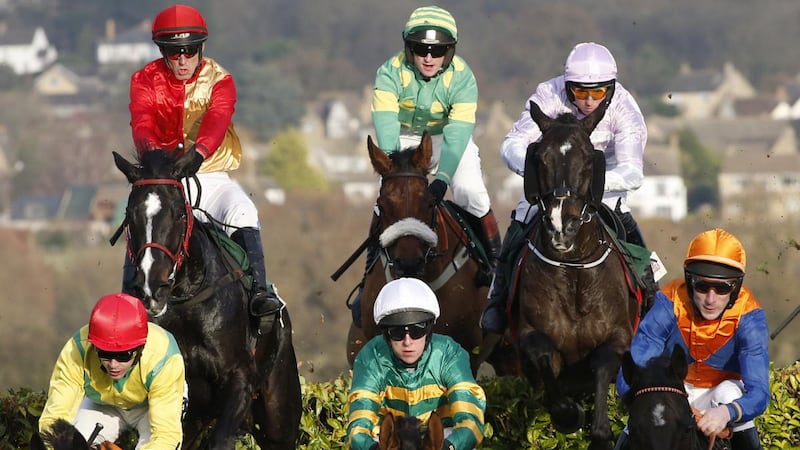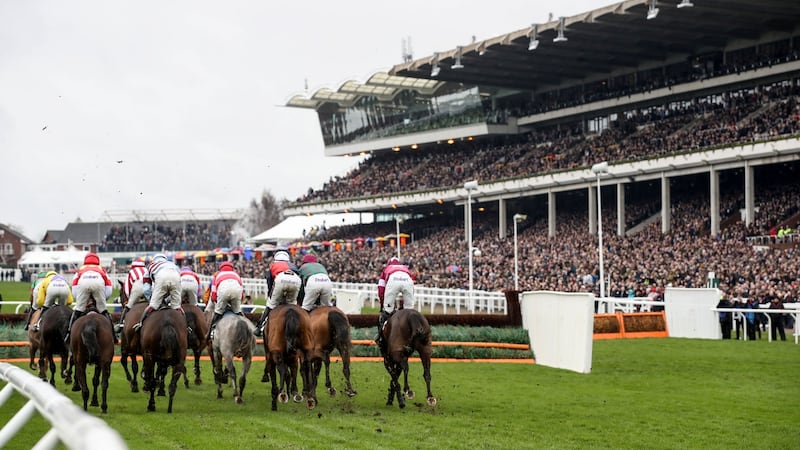You come in through the front gate, past the travelling women offering you heather and hocus-pocus. You slide along in the throng, past the stalls selling racecards with free pens included in the price. Past the towers of Racing Posts piled as high as horseboxes. You drop a right to round the corner of the Centaur building and then you hang a left to come around the front and you check your ticket and find your enclosure. And then, suddenly, there it is.
Cheltenham, hanging there in front of you like a Monet. The green sweep of the racetrack rushing up against Cleeve Hill and breaking into brown waves of gorse halfway to the top. If you’re there for the first time, it stops you in your tracks. If you’ve been there before you tend to stop anyway, partly trying to access that initial feeling again, partly reminding yourself that this is living.
As a spectator sport, horse racing shouldn’t really work. For the majority of your visit to any racecourse you are literally miles from the action. To follow what is happening, you rely on a distended voice on a PA system, either of which is liable to be a candidate for retirement.
Indeed, it’s a tribute to the sport’s durability that it has forced generations of racegoers to bring binoculars with them and nobody views this as an imposition. You either do it that way or you watch it on a big screen down by the winning post – an approximation of the home viewing experience, just minus all the warmth, comfort and chocolate biscuits.
A racecourse is also the only regularly used sporting venue where you can put down a day cheering for seven different teams in the knowledge that most of them will lose. Not to mention the fact that those defeats won’t just make you lower of spirit, they’ll leave you lighter of pocket too.

But then there’s Cheltenham. The National Hunt festival in March is one of the few slices of any sport impervious to fractured TV audiences, falling attendances, bickering over funding models, all that bad stuff. It took 83 years for the festival to be extended from three days to four in 2005; we can be certain that the shift from four to five will happen a lot quicker.
If you’ve ever been, you will readily attest to why this is. The racing is great, yes – Cheltenham is everyone’s ultimate target so you never have to worry whether your horse is trying to win or not. But it’s more than that as well. Going to Cheltenham just for the racing is like going to Glastonbury just to stand in front of the Pyramid Stage. It’s a great way to pass a few days but it’s kind of missing the point of the place.
I knew more or less the square root of nothing about Cheltenham the first time I went. And even less about horse racing. It was 2004 and I was sent by the Sunday Tribune for the week to cover the festival. It was my first time ever being at a race meeting. Emboldened by the fact that they didn’t appear to see my ignorance as any particular handicap, I strolled into the place presuming I had the measure of it. Predictably enough, I did not.
Growing up, racing was a sport that always seemed like a bit too much of a cryptic crossword. All the jargon, all the insider talk, all the nod and wink stuff. It felt like its own little enclave, living away happily behind an iron curtain and only letting you in if you had all your papers in order.
The general sports fan could watch a football match and tell you why this team won or that team lost and who played well and didn’t. Same with all the team sports, really. Hurling wasn’t really a thing up our way and neither was rugby. But when you sat down to watch a match, you knew who performed and who didn’t, what worked and what fell on its arse.
By contrast, racing was a language that was much harder to get on your ear. It seemed to be about betting, first and last. And if it was about betting, then it was about money. And if it was about money, then there were alternative delights more worthy of prising open the velcro on a teenager’s wallet. My dad wasn’t against gambling or anything but he used to say he’d look at a 20-pound note for a long time before he’d put it on a horse. “Sure the horse might fall,” he said.

Cheltenham changed all of that for me. That first view of the racecourse in 2004 was a genuine moment of revelation. It would obviously be overstating things to say that I suddenly got it. But it definitely triggered a realisation that there was something to get.
The landscape, the crowds, the buzz, the stands, the ring, the hill, the chute. All laid out in front of you before you ever see a horse or a jockey or a jump. There was too much life here for it all just to be about putting down a fiver in the hope of turning it into a tenner. That suddenly seemed like a very small way of looking at it.
For a start, there was just so much of it to go around. The grandstand was big then and it’s been improved in size and comfort in the years since. You had to be in a certain frame of mind to head for the Centaur or the Guinness village and thankfully for the people who built them, plenty were (and are). The parade ring has a sort of nervy waiting room vibe, the winner’s enclosure is Mardi Gras crossed with Puck Fair. Go to Cheltenham a dozen different days and you’ll see it a dozen different ways.
By complete accident one of the days, I ended up watching a race alongside the grooms just down at the bottom of the famous hill. I had got caught in cross-traffic, trying to go one way, being sent back the other and eventually just standing still and hoping nobody minded. A handful of these kids stood watching the screen, wincing with every jump, hands to their heads with every fall. Unable to look. Unable not to.
Nowadays, of course, the interview with the grooms is a staple of Cheltenham’s TV coverage. Maybe it was then too and I hadn’t watched enough of it or paid enough attention. One way or another, this was the sport from an angle I had never conceived of before. It was so much more visceral than waiting for a bet to come in. This was intense emotional investment. Hope. Love. Fear. Relief. Heartbreak. It was all there.
Ever since, it has always felt strange that racing doesn’t do more to tell its stories and that so much of the sport is conveyed to the public through gambling’s lens. “Any man’s life, truly told, is a novel,” wrote Hemingway. Well, run your finger through the racecards in any paper any day of the week and there are dozens of men, women, horses, lives. Every colour, every stripe. They’re not all novels, granted. But they’re more than bookie fodder too.

Cheltenham taught me that. In 2005, I stood on the inside of the course as Colm Murphy and Paul Nolan roared Brave Inca and Accordian Etoile up the hill. Two young, small-yard trainers from Wexford and their horses were second and fourth in the Champion Hurdle jumping the last. But the hill broke them both and Hardy Eustace saw it out. Murphy and Nolan were pure adrenaline by the end. They turned and embraced, eyes blazing. Alive.
This job takes you to a lot of sport in a lot of venues. In 20 years, there has been very little to compare to the half hour before the 2008 Gold Cup for tension and sheer electricity. Kauto Star was defending his crown against up-and-coming stablemate Denman and in that place for those 30 minutes, it was as if all conversations stopped. People walked past each other puffing their cheeks. Don’t know, don’t know. Maybe Kauto, maybe Denman. Maybe Denman, maybe Kauto.
We went down to stand at the last to watch it. They let us cross the track and stand on the inside of the fence, no more than 10 feet from where the animals passed on both circuits. When you’re watching from afar, be it in the stands or on TV, a big Grade One chaser clearing a fence looks kind of miraculous. They take flight in this gorgeous parabola, up and over and down and away. It looks like effortless poetry.
But of course, there’s no such thing. Not in life and certainly not in jumps racing. Up close, they clear those fences with a brutal, violent momentum. Denman jumped to the front at our fence at the end of the first circuit and as he passed us, it was like standing on a country railway platform as the Dublin train passes through without stopping. Not for nothing did they call him The Tank.
After a few years, money got tight and the paper stopped sending. But the racing stayed with me. The people, the animals, the tactics, the sport. I wrote a book with Ruby Walsh and learned more from him about what goes into performance at the highest level of sport than from anyone else before or since. I had the odd bet here and there, with the usual mixed results. Yer Man was right. The horse might fall.
If it doesn’t though, if it stays upright and keeps galloping and gets the trip and if the jockey doesn’t go too soon and if the trainer has picked the right race and the ground has come up just so, if all that happens and the planets align, then there’s only one place you’d want it to happen.












